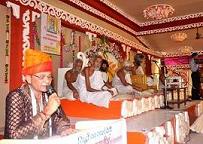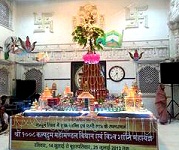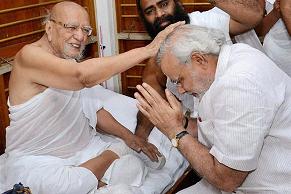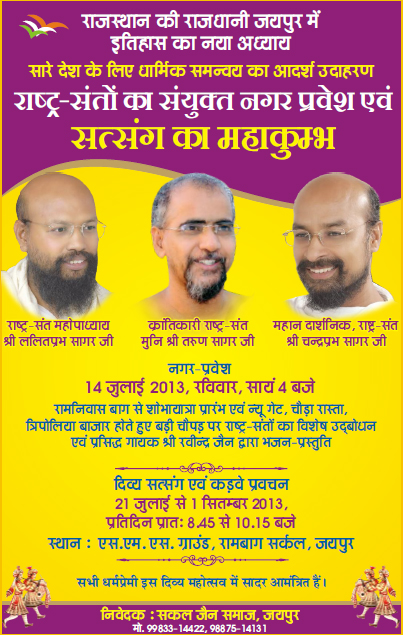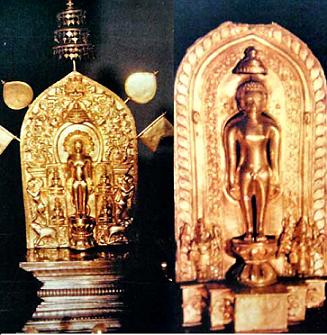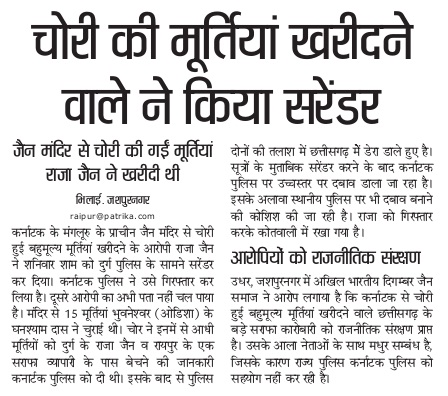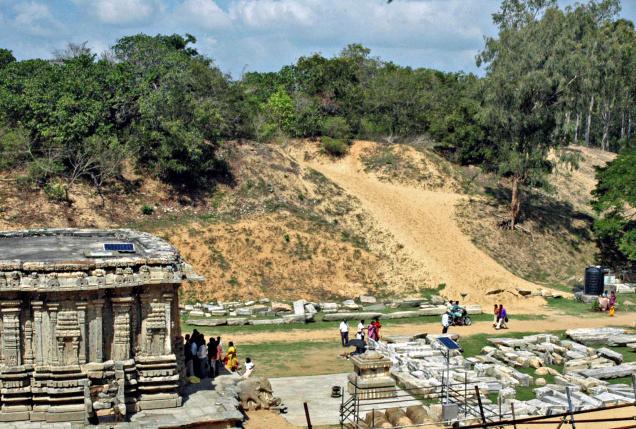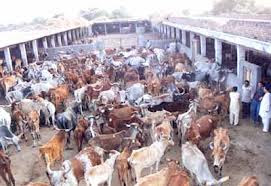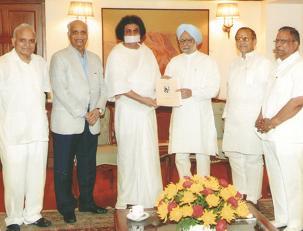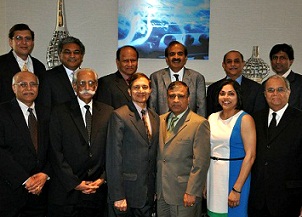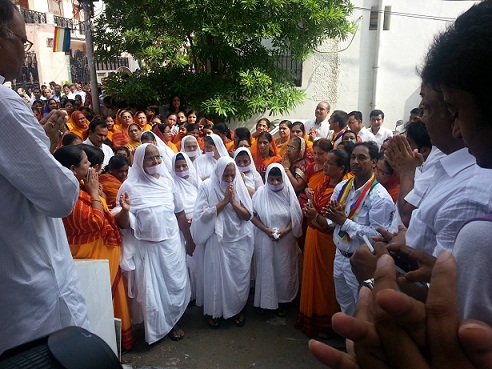
15.07.2013, Chaturmas Entry of Terapanth Sadhvi Vidhyavati (Second) at Gandhi Nagar, Delhi
साधना का सर्वोपरि अवसर है चातुर्मास. मुनि सुखलाल
भगवान महावीर ने ष्विहार चरिया इसिणां पसत्थाष् कहकर जैन मुनियों के लिए विहारचर्या को प्रशस्त बताया है। भगवान बुद्ध ने भी ष्चरथ भिक्खवे चारिकां बहुजन हितायए बहुजन सुखायष् कहकर बौद्ध भिक्षुओं के लिए ष्चरैवेति.चरैवेतिष् का संदेश दिया है। जैन मुनि के लिए शास्त्रों में नवकोटि विहार का संकेत है। उसके अनुसार जैन मुनि चातुर्मास में तो चार महीने एक स्थान में रहते हैं पर शेष आठ महीने एक.एक महीने कर कम से कम आठ स्थानों में प्रवास कर सकते हैं। वैसे इग्रविहारी होने के कारण वे एक वर्ष में सैकड़ों हजारों किलोमीटर की भी यात्रा कर सकते हैं। पर चातुर्मास काल में उन्हें एक ही स्थान पर प्रवास करना होता है।
|
कल्पसूत्र आदि अनेक सूत्रों में जैन-मुनियों की विहारचर्या की विशद चर्चा की गई है पर चातुर्मास काल में ‘वासासु परिसंवुडा’ के अनुसार वर्षाकाल में अपने आप को परिसंवृत होकर रहना पड़ता है। अर्थात् इस काल में वे ज्यादा घूमना-फिरना नहीं कर सकते। इसका प्रमुख कारण यह है कि जैन मुनि अहिंसा का सर्वोत्कृष्ट पुजारी होता है। वह स्थूल जीवों का वध तो कर ही नहीं सकता पर सूक्ष्म जीवों को हिंसा से बचाने का भी हर संभव प्रयत्न करता है। जैन धर्म में सूक्ष्म जीवों के अंतर्गत पृथ्वी, पानी अग्नि, हवा तथा वनस्पति काय को गिनाया गया है। एक जमाना था जब बहुत सारे लोग सूक्ष्म जीवों के अस्तित्व को स्वीकार ही नहीं करते थे। पर अब तो वैज्ञानिकों ने भी यह सिद्ध कर दिया है कि वनस्पति काय में भी जीवन होता है। वह भी पैदा होती है, बढ़ती है और नष्ट हो जाती है। स्थूल जीव भी पैदा होते हैं, बढ़ते हैं और अंत में नष्ट हो जाते हैं। उन्हें जिस प्रकार से सुख-दुःख की अनुभूति होती है उसी प्रकार सूक्ष्म जीवों को भी सुख-दुःख की अनुभूति होती है। इसीलिए जैन मुनि पृथ्वी, पानी, अग्नि, हवा तथा वनस्पति काय के जीवों की हिंसा से विरत रहता है।
यों तो वर्ष भर सूक्ष्म जीवों का अस्तित्व रहता है पर वर्षाकाल में वर्षा होने के कारण न केवल पानी के जीवों की ही बहुलता हो जाती है, अपितु सारी पृथ्वी वनस्पति काय के जीवों से संकीर्ण हो जाती है। वनस्पति काय की वृद्धि के साथ-साथ अनेक स्थूल जीवों का भी विकास हो जाता है। उनकी हिंसा से बचने के लिए मुनि प्रवृत्ति पर अंकुश लगाकर निवृत्ति पर विशेष लक्ष्य रखते हैं। इसीलिए चातुर्मास में उनका चार महीनों तक स्थिर रहना आवश्यक हो जाता है।
हर बदलते मौसम के साथ प्रकृति भी अपना रूप बदलती रहती है। वर्षा ऋतु में पानी बरसने से नदी-नाले उफान पर आ जाते हैं। पदयात्री होने के कारण वर्षा में जैन मुनि की पदयात्रा रुक जाती है। इससे पानी के जीवों की रक्षा तो होती ही है पर मुनि की अपनी आत्मरक्षा भी होती है। नदी-नालों में विहार करने से हर मनुष्य को अपने जीवन के लिए खतरा बन जाता है। जैन मुनि के लिए भी यह खतरा कम नहीं है। इसीलिए आत्मरक्षा के लिए चातुर्मास में उनके विहार पर प्रतिबंध लगाया गया है।
जैन मुनि वर्षा में भिक्षा के लिए भी अपने स्थान से बाहर नहीं निकलते। वर्षावास में कभी-कभी ऐसा होता है कि कई दिनों तक वर्षा नहीं रूकती। ऐसी स्थिति में मुनि भिक्षा के लिए बाहर नहीं जा सकता। उस समय उसे अपने स्थान में ही तपस्या करनी पड़ती है। वैसे चातुर्मास का कारण तपस्या के लिए काफी अनुकूल रहता है। गर्मी में प्यासा रहना बड़ा कठिन है। सर्दी में भूखा रहना बड़ा कठिन है। वर्षा ऋतु में भूख-प्यास पर सहज विजय पायी जा सकती है। इसलिए जैन परम्परा में चातुर्मास काल में हजारों-हजारों लोग आठ दिनों की तथा महीने-महीने भर की तपस्या करते रहते हैं। जैन परम्परा में तपस्या में कुछ लोग तो जल का भी उपयोग नहीं करते पर आहार का तो एक दाना भी मुंह में नहीं रख सकते। उस समय वे दूध, फल, मेवे आदि का भी उपयोग नहीं करते। उनकी तपस्या नितांत निराहार रहती है। जैनधर्म में आत्मशुद्धि के लिए तपस्या पर विशेष बदल दिया जाता है। हजारों लोग तो वर्ष भर में एक दिन भोजन करते हैं और दूसरे दिन उपवास करते हैं। इस तपस्या को एकांतर तपस्या कहा जाता है। इस एकांतर वार्षिक तपस्या का पारणा अक्षय तृतीया को होता है। पर जो लोग वर्ष भर एकांतर तप नहीं कर सकते वे लोग सावण और भाद्रव मंे विशेष रूप से एकांतर तपस्या करते हैं।
वर्षावास जैन परम्परा में साधना का विशेष अवसर माना जाता है। इसलिए इस काल में वे आत्मा से परमात्मा की ओर, वासना से उपासना की ओर, अहं से अर्हम् की ओर, आसक्ति से अनासक्ति की ओर, भोग से योग की ओर, हिंसा से अहिंसा की ओर, बाहर से भीतर की ओर आने का प्रयास करते हैं।
वर्षावास में एक स्थान पर रहने के कारण जैन मुनियों को ध्यान-स्वाध्याय का भी अच्छा अवसर मिल जाता है। इस अवसर पर वे लंबी ध्यान-साधना तथा बड़े-बड़े आगम ग्रंथों का स्वाध्याय करने में लीन हो जाते हैं।
जैन परम्परा में वर्षावास आषाढ़ पूर्णिमा या श्रावण प्रतिपदा से शुरू हो जाता है। आषाढ़ पूर्णिमा को पूरे भारत में गुरु पूर्णिमा के रूप में मनाया जाता है। जैन धर्म में वर्षावास स्थापना की एक विशेष विधि होती है। उसमें सामायिक संवर के साथ-साथ मंत्रोच्चार का भी विशेष अभिक्रम चलता है। चातुर्मास अपने आप में तो एक पर्व है ही पर इस कारण के अंतर्गत पर्युषण-दशलक्षण धर्म की भी आराधना की जाती है। भाद्रव महीने के श्वेताम्बर परम्परा द्वारा पर्युषण संवत्सरी एवं दिगम्बर परम्परा द्वारा दसलक्षण-क्षमावाणी का जैनधर्म का सर्वोत्कृष्ट पर्व होता है। इस अवसर पर पूरा जैन समाज उपवास-पौषध कर अपना आत्मालोचन करता है। अपनी भूलों के लिए दूसरों से क्षमा मांगता है तथा दूसरों की भूलों के लिए स्वयं क्षमा प्रदान करता है। क्षमा का यह महोत्सव अपने आप में एक अद्भुत महोत्सव है।
कार्तिकी अमावस्या के दिन भगवान महावीर का परिनिर्वाण हुआ था। अतः उस दिन को दीपावली के साथ-साथ निर्वाणोत्सव के रूप में त्याग-तपस्या के द्वारा अत्यंत भव्य रूप में मनाया जाता है। इस प्रकार जैन परम्परा में साधु-साध्वियों तथा श्रावक-श्राविकाओं के लिए आत्मसाधना के लिए वर्षावास को एक अनुपम अवसर माना गया है। प्रस्तुतिः ललित गर्ग, ई-253, सरस्वती कुंज अपार्टमेंट, 25 आई. पी. एक्सटेंशन, पटपड़गंज, दिल्ली-92, मोः 9811051133.
परस्पर सहयोग से ही जीवन स्वर्ग बनता है- उपाध्याय मणिप्रभसागर
|
जैन श्वेताम्बर खरतरगच्छ श्री संघ के उपाध्याय प्रवर श्री मणिप्रभसागरजी म.सा. ने विशाल धर्म सभा को संबोधित करते हुए कहा- समाज एक परिवार है। परिवार में जैसे हम सभी आत्मीयता के साथ जीते हैं।
एक दूसरे के प्रति पूरा उत्तरदायित्व निभाते हैं, ऐसे ही हमें समाज में जीना होता है। जिस समाज में एक दूसरे के सुख में सुखी और दुख में दुखी हुआ जाता है, वही समाज प्रगति करता है। आज हमारे समाज की क्या दशा है, यह प्रश्न बहुत महत्वपूर्ण है। समाज को उँचा उठाने के लिये हर व्यक्ति को पुरूषार्थ करना होगा। एक दूसरे के प्रति सहयोग का भाव रखना होगा। मैं तो मैं हूँ ही, वह भी मैं हूँ, यह सूत्र हमारे मन मानस मस्तिष्क में प्रतिष्ठित होना चाहिये। तो दूसरा हमें दूसरा नहीं लगेगा। उसका काम मेरा काम महसूस होगा, तो परनिंदा नहीं होगी, क्रोध् नहीं होगा, ईष्र्या और द्वेष भी नहीं होगा।
कुबेर अपना समस्त वैभव लुटा देता है समवशरण में - एलाचार्य अतिवीर मुनि
|
त्रिलोक तीर्थ प्रणेता परम पूज्य आचार्य श्री 108 विद्याभूषण सन्मति सागर जी महाराज के शिष्य परम पूज्य एलाचार्य श्री 108 अतिवीर जी मुनिराज के परम पावन सान्निध्य में राजधानी दिल्ली की धर्मनगरी अशोक विहार स्थित श्री 1008 महावीर दिगम्बर जैन मन्दिर जी, फेज़-1 में अष्टाह्निका महापर्व के पुनीत प्रसंग पर पूज्य एलाचार्य श्री ने श्री 1008 कल्पद्रुम महामंडल विधान का महात्म्य समझाया तथा बताया कि किस प्रकार कुबेर अपने समस्त सम्पदा का वैभव तीर्थंकर भगवंतों के समवशरण में लगा देता है। अमूल्य रत्नों से निर्मित किया जाता है समवशरण का चबूतरा जिसके आगे दुनिया का समस्त वैभव फींका लगने लगता है। एलाचार्य श्री ने आगे बताया कि केवल भव्य जीव ही भगवन के समवशरण में प्रवेश पाते हैं। इस विधान के माध्यम से हमें अपने कर्मों की निर्जरा का पुरुषार्थ कर परम पद की प्राप्ति हेतु प्रयास करना चाहिए। Source: Sameer Jain, E-Mail:, Website:www.shriativeer.blogspot.com
यदि कोई पिल्ला भी कार के पहिये के नीचे आ जाए तो मुझे दुख होगा - नरेन्द्र मोदी
बंधुओं, गुजरात के मुख्यमंत्री जी द्वारा 12 जुलाई 2013 को टिप्पणी की गयी कि,"यदि कोई पिल्ला भी कार के पहिये के नीचे आ जाए तो उन्हें दुख होगा।" मुख्यमंत्री जी द्वारा की गयी टिप्पणी या उनके विचार अच्छे है क्युकी किसी छोटे से जानवर के भी कार के नीचे आकर मरने से उन्हें दुःख होगा लेकिन गुजरात में जैन धर्मं के संतों पर जान-लेवा हमलें या उनकी दुर्घटनायों में मौत पर उनके द्वारा क्यों दुःख प्रकट नहीं किया जाता?,क्यों? क्या संत केवल धार्मिक आधार पर पहचाने जाते है? गुजरात में निम्न तारीखों में जैन संतो को सडको पर कुचल कर मारा गया।
|
1. गिरनार पर्वत पर वर्ष 2013के पहले ही दिन दिगम्बर जैन संत को दिन में सरे - आम चाकू मारकर देर तक बैठाये रखा गया। गुजरात सरकार का कौन सा मंत्री घटना वाले दिन या अगले दिनों में मुनि श्री को देखने अस्पताल गया?सारे भारत के जैन समाज द्वारा 2से 15जनवरी 2013तक धरना, प्रदर्शन किये गए। गुजरात के मुख्यमंत्री कार्यालय द्वारा 15दिन बाद 16जनवरी को केवल इ-मेल द्वारा जबाब दिया गया क्यों?
2.दो श्वेताम्बर जैन संतों को वर्ष 2013के पहले ही दिन भरूच के पास असुरिया गाँव में सडक दुर्घटना में असमय मौत।
3. एक जैन साध्वी को 11 जुलाई 2013 को कलोल - गोधरा हाईवे पर सडक दुर्घटना में असमय मौत।
4. एक जैन साध्वी को 2 जनवरी 2013 को बडोदा के पास सडक दुर्घटना में असमय मौत।
5. एक जैन साध्वी को दिनांक 27 मई 2012 को अहमदाबाद के पास सडक दुर्घटना में असमय मौत।
6. जैन साध्वियों को 10फरवरी 2010 को राजकोट-अहमदाबाद हाईवे पर लिम्बडी के पास सडक दुर्घटना में असमय मौत।
7. चार जैन साध्वीयों को 9 नवम्बर 2009 को सोनेरिपुरा पटिया (महसाना के नजदीक) और दो जैन संतों को 13 नवम्बर 2009 को उंझा के पास सडक दुर्घटना में असमय मौत।
8. नवम्बर 2009 में पालिताना में आचार्य श्री अभयसूरीश्वेरा म. सा. और श्री मोक्षरत्न विजय जी म.सा. को जान से मारने के धमकी भरे दो पत्र एक सफताह में किसी संगठन द्वारा भेजे गए, क्युकी जैन समाज द्वारा जैन संतों की सडक दुर्घटनाओं में मारे जाने पर न्यायिक जाँच की मांग कर रहे थे। सरकार ने आज तक क्या कार्यवाही की?
उपरोक्त विषय को लिखने का उद्देश्य केवल अपने दुःख को प्रकट करना है जो सकल जैन समाज द्वारा उनके चलते-फिरते तीर्थ समान संतो को गुजरात की सड़कों पर असमय मौत देता है। ऊपर लिखे किसी भी शब्द से किसी को भी आपत्ति हो या दुःख हो तो क्षमाप्रार्थी हूँ। संजय जैन - विश्व जैन संगठन।
JAIN SADHVI KILLED IN ROAD ACCIDENT
Jul 11, 2013, Vadodara: A Jainsadhvi died on the spot after being run over by a speeding vehicle near Delol village in Kaloltaluka of Panchmahal district.The sadhvi Purvisha Mahasatiji had left Kalol for Godhra along with two other sadhvis on foot as per tradition. She was the last amongst the queue of the three sadhvis and was hit by a vehicle around 6.30 am, suspected to be a four-wheeler. She died on the spot due to injuries. The sadhvi had started her journey on foot from Vadodara. She then took a halt at Kalol. The 55-year-old victim had become a sadhvi by taking deeksha 33 years ago. She was to reach Godhra on foot and fast and pray there during the 'chaturmas'. Kalol police station has registered an offence regarding the incident and is conducting further investigations.
DIAGAMBER AND SWETAMBER SAINTS AT JAIPUR SET NEW EXAMPLE FOR REST OF THE DIASPORA
Jaipur: For the first time in the history of Jain religion, Swetamber (Muni Lalitprabh Sagar Ji & Muni Chandraprabh Sagar Ji) and Digamber saints (Muni Shri Tarun Sagar Ji) will come together and participate Chaturmas programmes from a single venue. The credit goes to community members of both the sects and also to the local sectarian community leadership. The saint community should also be appreciated and commended for their progressive views and understanding. Saints from both communities will address their discourse for continuously 43 days from SMS Investment Ground at Rambagh, Jaipur. The Jaipur initiative is expected to have far reaching impact in times to come. May be next year we will have many such unions in and outside country.
|
TEMPLE
SHOCKING - RARE JAIN IDOLS STOLEN FROM MOODABIDRI JAIN TEMPLE
Moodabidri (Dakshina Kannada District, Karnataka), July 6, 2013: Rare, precious Jain idols have been stolen from the 'Siddantha Darshan Temple' at Moodabidri, the Jain Kashi. The theft came to light next morning. Temple authorities said that, the theft has happened on the night of July 5, 2013. They further added that they are yet to confirm the actual no. of idols stolen and their exact worth. However, the total worth of all the Jain idols are said to be several crores as there were several precious idols. The thieves are said to have done this in a very planned way by cutting the security system using gas cylinders. Interestingly it is yet to be confirmed that, if any siren alerts had also gone.
|
The CCTV footage in the temple shows that the theft was conducted by a single person wearing a mask. The Siddantha Darshan Temple was temporarily locked after the initial inspection by the police. On the date of theft His Holiness Swasti Sri Charukeerthi Bhattarakha Pandithacharya Swamiji, the pontiff of Moodabidri Jain Mutt was in United States of America (USA) to attend the biennial conference of Jains Association in North America (JAINA). What is Siddantha Darshan? Siddantha Darshan is an arrangement of Jain idolands made of precious stones that include Sapphire, Manikya, Pachhe, Neela and many other precious stones. The darshan of these idols is restricted only to the Jains owing security reasons. Dr. D. Veerendra Heggade Dharmadhikari of Sri Kshetra Dharmasthala visited Moodabidiri after the incident and has expressed shock over the incident and urged the Government of Karnataka to punish the culprits. The community members from different parts of the country have expressed their concerns on this unfortunate incidence and hope that the administration will take suitable steps to trace the stolen treasure of the community. Nitin H.P. the executive director of www.jainheritagecentres.com has expressed shock over the incident and has condemned the incident. Moodabidri's Charukeerthi Bhattarakha Swamiji's is cutting short his US visit. In a email to Nitin H.P. he has expressed shock on this news.
The temple committee, which met after the theft to review the security, found that the surveillance cameras had not been monitored. According to investigators, the burglar would have made several recces before executing the operation. Though there were 64 statuettes, only 12 of them were extremely precious. Another source told dna that the though there was an alarm system installed in the shrine, it remained switched off or had been never been used or tested for accuracy. The idols—which are said to be worth nearly Rs45 crores—were donated to the Jain math by devotees as a part of a unique tradition and religious practice called Udyapana at the end of ‘Nompi’—a Jain religious practice.
The devotees offer statuettes to the Basadi (temples) after observing Nompi periods, varying from seven days to 21 years. These statuettes were kept in the temples and each of them had the names of devotees who donated them to the temple. President of the Jain Religious Establishment Committee Vidyadhar Shetty said the statuettes had been donated by merchants and businessmen of Jain community. “They had trade relations with Africa and China which can be traced to the 11th century. Merchants from Moodbidri had brought precious stones from Africa and used them to decorate the statuettes they had donated to the temples,” Dr Shetty told. The Siddantha Shrine was built by Jain leader Sahu Shreyansh Prasad Jain (Times of India Group) of Mumbai in 1977.
TWO HELD IN KARNATAKA JAIN TEMPLE THEFT CASE
July 16, 2013,Bhubaneswar: Karnataka Police have arrested two persons from here in connection with the theft of antiques from a Jain Temple near Mangalore and seized about 1 kg gold from their possession. The arrested persons were identified as Diptimayee Mohanty, wife of Santosh Das, the prime accused in the theft case and Digambar Mohanty, his father-in-law. Santosh is still at large. Police has not confirmed the details of seizure. At least 15 Jain idols made of gold, pearls, precious stones and diamond, were stolen on July 5 night from Siddantha Mandir of Guru Basadi in Moodbidri, locally known as ‘Jain Kashi’. The shrine had total 64 idols of religious importance to Jains. Late News in the block herein below, Courtesy: Sahu R. P. Jain, New Delhi.
|
SCANT SECURITY AT PATNA MAHAVIR MANDIR WORRIES TEMPLE MANAGEMENT
Patna: A day after the state government initiated security measures at the Mahavirsthan near Patna Junction in view of the serial blasts in and around the Mahabodhi Temple in Bodh Gaya, the Mahavir Sansthan Nyas Samiti has expressed dissatisfaction over the "inadequate security" at the city temple. A door-frame metal detector was put up at the entrance of the temple and three constables, including a woman, were deployed along with one temple representative in each shift to frisk the devotees visiting the temple. They are also checking the hand baggage of the devotees. However, Samiti secretary Acharya Kishore Kunal felt three cops were inadequate to man a crowd of at least a thousand devotees every shift. The people in the temple parking area and at the shoe stand are not being frisked. Security has also been beefed up in the famous Jain Temple of Pawapuri, Shanti Stupa at Rajgir, Nalanda ruins and Bramha Kund.
BANGADY JAIN BASADI THEFT CASE SOLVED, 7 NABBED, IDOLS SEIZED
Jul 19, 2013,Mangalore: Dakshina Kannada district police has solved a Jain basadi theft case of Belthangadi taluk by arresting seven and seizing ancient Theerthankara idols. With the arrest of the seven, the police also could solve four more cases of temple thefts carried out in DK and Udupi by the gang. Police have recovered six Jain idols stolen from a basadi in Belthangady taluk, 20kg of silver, 18.3 grams of gold and also seized three vehicles and lethal weapons used for the theft from the accused. The arrested are Thimmaiah alias Thimma (55), sone of late Range Gowda of Eradakere village of Kadur in Chikmagalur, Somanatha alias Somesha alias Kulla (45), son of late Papaiah Vasala of Harnalli, Arasikere in Hassan district, Jayaraj (45), son of Eera Shetty, Kuvempu Nagar, Hassan, Ganga alias Gangaraj (40), son of Krishne Gowda of Kallahalli in Hassan, Nethra alias Nethravathi alias Nethramma (38), wife of Ananda of Mathoor village in Shimoga, Babu alias Rudra (55) from Uppinangady and Rajendra (65) from Shimoga.
The gang had stolen six panchaloha Jain antique idols of Theerthankara by barging into Bangady Basadi in Belthangady taluk on June 18. Though the total value of the seized items is estimated at Rs 17 lakh, the actual can be ascertained only by Archaeological Survey of India (ASI) as the panchaloha idols stolen from basadi are ancient. "While 8.5kg of silver ornaments and vessels were found in its original shape, remaining items were converted into ingots. We have decided to send the ancient idols of Theerthankara to the ASI for evaluation of its origin and value," he added and said thatRajendra, Thimmaiah are Somanatha involved in various theft and other cases at many places in the state.
JAIN BASADI AT TALAKAD TO BE EXCAVATED
MYSORE, July 23, 2013, The ancient site of Talakad continues to beckon archaeologists and explorers hoping to uncover the world buried in the sands of time. And now, the Department of Archaeology, Museums and Heritage will excavate a Jain basadi reckoned to have been built in the 8th century. R. Gopal, Director (Archaeology), told The Hindu that excavations conducted in the past had revealed a portion of the Jain basadi, but its importance and significance remained unclear. “It is only after it is completely excavated that we can ascertain its importance,” he said.
|
Though a State-protected site, the department has to secure permission from the Archaeological Survey of India (ASI). Dr. Gopal has applied for the permission. He said that in all probability, the excavation would commence in October and be completed by March. While the architectural merits of the structure will be an area of separate study, what is of critical importance is the data that the excavation may throw up that can help weave a new strand of historical narration to Talakad by future generation of scholars and historians.
“The importance of the excavation, which may cost around Rs. 3 lakh, lies in the reconstruction of the history of the region that spans more than 1,500 years,” said Dr. Gopal.Talakad is one of the oldest historical sites in the State and was the capital of the Gangas in the 6th century. Located on the banks of the Cauvery, it was under the Cholas for many years and was called Rajarajapura after king Raja Raja Chola. The Chola kings constructed many temples there. Subsequently, it was captured by Hoysala ruler Vishnuvardhana by subjugating the Cholas. The Keerthi Narayana temple, which is now in ruins, and is being restored by the Archaeology Department slab by slab, was constructed to mark the Hoysala king’s victory over the Cholas in 1,116 CE. The construction of a dam by Madhavamantri across the Cauvery in the 16th century is reckoned to have led to accumulation of large mounds of sands in the vicinity of Talakad, which over the centuries, got buried under it. This will be the third major excavation to be taken up at the site since the 1990s when systematic efforts were made to rediscover the buried town. Excavations unearthed portions of temples, including the Keerthinarayana temple, Pataleshwara, Maruleshwara and Vaidyeshwara. In recent years, the department has taken recourse to remote sensing and satellite imagery to explain the sand dunes. It has been attributed to the shifting course of the Cauvery in the last 500 years.
AHIMSA, COMPASSION
INDIAN CONSTITUTION AND SUPREME COURT CONFIRM THE CONCEPT OF COMPASSION IN ARTICLE 51A (g) READ WITH ARTICLE 21
Indian Parliament in the year 1976 incorporated article 51A (g) in the constitution with a view to direct our citizens to perform a fundamental duty of not only protecting and improving the natural environment but also to have compassion for living creatures and also article 51A (i) to abjure violence.
|
Honourable justice Ravi S Dhavan and V. P. Goel expressed in writ petition no. 38469 Dated:-1/8/1997 that constitution does not permit any citizen to claim that it is his/her fundamental right to take life and kill animals. Otherwise it will be a negation of tenet of Indian constitution. Treating animals as commodities and not as living creatures with compassionate approach is gross violation of article 51A(g) by slaughter houses. Following the aforesaid constitution provision, it becomes the fundamental duty of state to come forward and start the process of closing slaughter houses which carryon the cruel business of animal slaughtering.
Such an observation of excellence by Supreme Court should not be ignored by a rational administration. As otherwise the Nation would be misguided towards unhealthy and miserable life of people at large. Article '14 also speaks that the right of animals like human rights should enjoy the protection of law. In furtherance of above it is worthwhile and significant to observe the attitude of nation towards animals. In one of the cases by the Kerala High Court (Times of India, dated 7/6/2000) observed, "animals have inherent rights of dignified existence akin to the fundamental rights of citizens". In a landmark judgement Allahabad High Court significantly observed that Article 21 will prevail towards Right to business as mentioned in Article 19(1)(g), slaughter houses cannot be allowed to run anywhere and everywhere. {Manzoor Ahmed's case).
Supreme court has rightly kept national interest in view when it said that, welfare of animals is of paramount consideration (AIR 2001 SC 2377). Keeping in view the above observations, it would be appropriate for us to express our written and vehement protest "against the Himsak proposal of setting up' abattoirs and establishing Indian Meat Board in order to promote the massive killing of animals by way of erecting huge plants of slaughtering innocent animals.
|
A PERSPECTIVE ON PANJRAPOLES (ANIMAL SHELTERS) OF INDIA BY BRETT EVANS
During my undergraduate education, I researched Jainism as part of the Elon College Fellows and Lumen Scholars programs at Elon University in North Carolinawww.elon.edu. As a vegan, I became interested in Jainism primarily due to its impressive and longstanding commitments to nonviolence, vegetarianism, and panjrapoles (animal homes). In the context of this project, I visited 27 Jain panjrapoles in India and a number of goshalas (cow homes). I had the opportunity to tour these institutions and interview their managers, trustees, and donors. In total, I discussed panjrapoles with more than 100 Jains who were closely connected to these organizations. In between my two trips to India, a number of respected Jains living in the US raised concerns to me about the conditions present in panjrapoles today. Many of them noted that while they donate to panjrapoles in India, they are uncertain if these charitable organizations are well-run or truly worthy of their support. These individuals had heard many negative reports about panjrapoles, and they hoped that I might be able to shed some light on the situation.
|
Although assessing the value of these institutions was not the aim of my research project, I agreed to give my honest perspective on panjrapoles when I returned. I agreed because, like you, I am passionate about animal welfare and helping to create a less violent world. In this spirit, and based upon the experiences of my research field work, I offer you my perspective here. It is my hope that this essay may start a conversation about panjrapoles and how our personal choices may lead to animals being abandoned and slaughtered. If my perspective is incomplete or causes unintentional harm, micchami dukkadam.
This longevity exhibits the relevance and importance of these institutions in a time of unprecedented slaughter and mistreatment of animals. Such a rich tradition, then, has much to teach those around the world who are involved with contemporary animal rights and welfare movements. Over its long history, many Jains have devoted their human lives to saving and improving animal lives, and even today I did not meet a single panjrapole trustee who was not undoubtedly committed to the cause of protecting life. Indeed, many spent significant amounts of time away from their families and businesses to ensure their charitable work was done.
During my time in India, I was continually impressed and humbled by these individuals. These supporters are faced with a very challenging situation, however, and many, including me, would argue that panjrapoles need improvement and cannot be the only solution to animal suffering. I would like to pose a broad but crucial question: what is the purpose of a panjrapole? While this query may seem elementary, I believe it is essential that we take a step back in order to chart a way forward. The most common answer I heard to this question is that a panjrapole’s purpose is to protect animals who would otherwise be abandoned or slaughtered. However, if this is the purpose of the panjrapole, we must ask why animals are being abandoned and slaughtered in the first place. There is a clear answer to this question, and it is readily apparent upon visiting most panjrapoles.
|
Overwhelmingly, animals living in these institutions are older female cows who are no longer able to produce milk and male calves (who obviously do not have the capacity to produce milk). These animals have been deemed “useless” because they are not profitable to the dairy industry. Neither the dairy industry nor the independent farmer can afford to maintain these unprofitable animals and, as a result, they are abandoned or shipped illegally for slaughter in Maharashtra.
Given this situation, the panjrapole serves as one important solution. However, it is only a temporary, stop-gap solution. If we regard panjrapoles as a permanent solution, then they (and we) are simply enabling a system that produces the injustice of abandoned and slaughtered animals, and the milk producers continue to profit at the expense of the panjrapoles, who bear the burden of taking in the old females and young males. This “solution,” which effectively redistributes rather than reduces dairy’s violent outcomes to panjrapoles, is neither sustainable nor equitable. Moreover, it is widely acknowledged by panjrapole supporters that these institutions are only able to take in a tiny percentage of the animals in need. This lack of housing capacity is obvious when you consider the amount of milk products consumed in India. It would be impossible for panjrapoles to house the hundreds of millions of cattle and buffaloes who produce milk across the country.
We must remember that half of this number, the male population, is cast aside immediately and that young, lactating females naturally would be outnumbered by their older, “unproductive” counterparts. And, these figures do not even include goats, sheep, birds, dogs, cats, and the rest of animals in need who are not used for mainstream dairy but are currently minority residents of panjrapoles. As it is, most of the panjrapoles I visited were incredibly overcrowded. Many of these panjrapoles were originally built on grazing grounds outside of cities, but, as these metropolises developed, the animal homes were eventually swallowed by them. Urban expansion means that panjrapoles are now located in confined, polluted environments that are not well-suited to animals.
While many managers and trustees admit this is a problem, most stated it is not financially feasible to relocate. Few panjrapoles can afford to provide any space for animals to roam or graze, which means that the animals in these shelters typically have an unnatural and poor quality of life—one which is better than starvation or slaughter but not one which we would find an acceptable, systemic outcome for countless individuals. It is with the circumstances that I have outlined above in mind that I advocate for a permanent solution that strikes at the root of the problem panjrapoles are intended to address. This solution is surely familiar to many of you: It is to adopt a Vegan (strict or pure vegetarian) Lifestyle.By choosing to be strict vegetarian and not consume dairy products, you are ensuring that the demand for milk falls and thus less milk will be produced. When industry produces less milk, fewer young male and older female cows will be bred, and subsequently abandoned or sent for slaughter, and fewer animals will need to be housed in panjrapoles.
This nonviolent action moves us toward a sustainable and equitable solution that will one day allow panjrapoles to dedicate their resources towards truly needy and injured animals. As long as we consume non-human dairy, something will need to be done with the young males and older females who are deemed “useless” because they have no role in the production process. Panjrapoles alone cannot be the answer. There are too many animals in need, and too few panjrapoles. Please consider veganism. This practice avoids the violence inherent in dairy and is very closely aligned with the core Jain tenets of ahimsa, jiv-daya (compassion for life), and parasparopagraho jivanam (all life is bound together by mutual support and interdependence). Author:Brett Evans, E-Mail:,Elon Community Garden and Loy Farm Manager,Office of the University Registrar, Research Assistant,Elon University, North Carolina, USA. Courtesy: Dr. Sulekh Jain.
A GIANT LEAP FOR AHIMSA
July 13, 2013, Getting rid of animal testing has long been on the agenda for several rights groups which draw attention to what a lab animal goes through, especially when there are compassionate alternatives available.
|
. “Mice, guinea pigs and rabbits are made to endure painful tests such as skin and eye irritation, in which chemicals are rubbed onto the shaved skin or dripped into the eyes,” say Alokparna Sengupta and Nuggehalli Jayasimha of Humane Society International (HSI), India, one of the key organisations that helped bring about the ban. They reveal that rabbits are chosen because they cannot cry, and hence have no natural way of weeping the harmful chemical away. “Other tests include repeated force-feeding studies lasting weeks or months to look for signs of general illness; and even widely condemned “lethal dose” tests, in which animals are forced to swallow massive amounts of a test chemical to determine the dose that causes death. At the end of a test, the animals are killed, normally by asphyxiation, neck-breaking or decapitation.”
The good news is that the Bureau of Indian Standards has declared this abuse illegal. The even better news is that companies that have always been cruelty-free will have the well-deserved advantage of being ahead of the curve. Natasha Shah, founder of the successful Mumbai-based cosmetics company The Nature’s Co, welcomes this milestone. She states that her organisation finds animal testing morally wrong. “We use in-vitro methods i.e. clinically using the products on human skin, on people who voluntarily participate in the same,” she says, adding that an animal test is meaningless as their biology differs so widely from that of humans. She points out that the cruelty-free label has a significant following in our country. “We have loyal customers from The Vegan Society that recommends our products in their social groups and networks. A lot of customers appreciate the fact that no honey, eggs, milk, beeswax, lanolin or musk is used in any of our formulations”, says Shah.
What does being a cruelty-free company mean?
1.Doesn’t test ingredients or the finished product on animals
2. Doesn’t hire a third party to conduct these tests on their behalf, or purchase from suppliers who test on animals
3. Doesn’t sell in regions like China where animal testing is mandatory
EVENTS, SEMINARS, CONFERENCES
DIVIDING SOCIETY ON RELIGIOUS BASIS IS WRONG - PRIME MINISTER
New Delhi, July 24, 2013: Prime Minister Dr. Manmohan Singh said that dividing society on the basis of religion for small political benefits is betraying both religion and civilization.
|
Such actions should be condemned and criticized. Dr. Singh was addressing the delegation of Ahimsa Vishwa Bharti and Jain Community under the leadership of Acharya Dr. Lokesh Muni. Prime Minister religious fanaticism and blind faith is creating difference in our mixed culture. In such circumstances efforts of Ahimsa Vishwa Bharti under the leadership of Acharya Lokesh Muni through national campaign to spread communal harmony is very relevant and appreciable. Dr. Singh said promoting religion intolerance for political benefits is more harmful than religion intolerance. Any political Party which provokes people on religious grounds betrays both religion and society.
Dr. Singh said all religions are given equal respect in our constitution. When we say our constitution is secular it means religion is separate from politics and governance. He said that thought of equality is important. When we talk about multifold society this numerical thought is based on political and social principles. He said all religions are similar as all human beings are similar. So we treat all religions equal and make efforts for mutual amiability. Dr. Singh said that Bhagwan Mahavir message of religious harmony is relevant presently and will be relevant in future also. Appreciating the contribution of Jain Community in national development and social welfare he assured that Jain Community will be soon given the Minority status at National level. He agreed with Acharya Lokesh Muni that the greatness in Indian Culture is the presence of different religions in India which have inter-religion harmony. Source: Kenu Agarwal,Media Convener, Ahimsa Vishwa Bharti, Acharya Lokesh Ashram, New Delhi - 110060, E-Mail:,www.ahimsavishwabharti.org
JITO TO HOLD MATRIMONIAL MEET AT JAIPUR
Jain International Trade Organisation popularly known as JITO is holding its first matrimonial meet at Jaipur on 29th September at Anuvibha Kendra, Gaurav Tower, JLN Marg, Jaipur. The interested parents and candidates may check JITO website for details and registration.
NATIONAL JAIN MINORITY CONFERENCE IN PUNE (MUST COME)
A national Conference for demanding National Minority Status for JainCommunity is being held at Pune on 28th July 2013. (9 to 5). The venue of the conference will be Shri Vardhman Swetambar Stanakwasi Jain Shravak Sangh, Bibwewadi,Pune. For further information contactDakshin Bharat Jain Sabha,37, Mahaveernagar, SANGLI (Mh) 416416,Ph.0233-2623603.
JAINA TO CREATE A MILLION-DOLLAR EDUCATION FUND
|
16-Jul-2013, Detroit: An umbrella organization of 72 Jain associations in the US and Canada plans to create a one million dollar educational fund to support needy Jain families. The decision was announced at the 17th biennial convention of the Federation of Jain Associations in North America (JAINA) with the theme ‘Jainism: The Global Impact’ held July 4-7 in Detroit. Sam Pitroda, chairman of the National Innovation Council was the keynote speaker at the convention attended by over 3,500 delegates, including a couple of hundred from outside North America. The vast majority of some 150,000 Jains in North America emigrated in the 1960s and 1970s, and was predominantly entrepreneurs and professionals.
The programming focused on multiple ways that Jainism has impacted the world on July 9 and will continue to do so in the future, according to a media release. Speakers addressed current global issues with inter-faith panel discussions with representatives from all major religions. Gurudev Chitrabhanuji, Muni Roop Chandraji, Acharya Chandnaji and Guruvanand Guruji were among Jain monks and scholars from around the world attending the convention.
Outgoing President Sushil Jain recognized the efforts of JAINA committees, projects, volunteers and personnel and emphasized JAINA's three major objectives: to increase the presence of youth and women in JAINA; to create a JAINA general fund for JAINA projects, committees and initiatives; and to make JAINA a sustainable organization for future generations of North American Jains. The incoming President Mr. Prem Jain unfolded his JAINA vision saying, "I would like to make JAINA a global organization by ensuring that it is financially strong. By working together, we can make JAINA the #1 service organization for the Jain community in North America..." The new team of Prem Jain includes, Ashok Domadia, Gunvant Shah, Yogendra Jain, Dr. Sushil Jain, Dr. Jayesh Shah, Haresh Shah, Hemant T. Shah, Rajeev Pandya, Rajendra Mehta, Piyush Mehta, Raj Patil.

